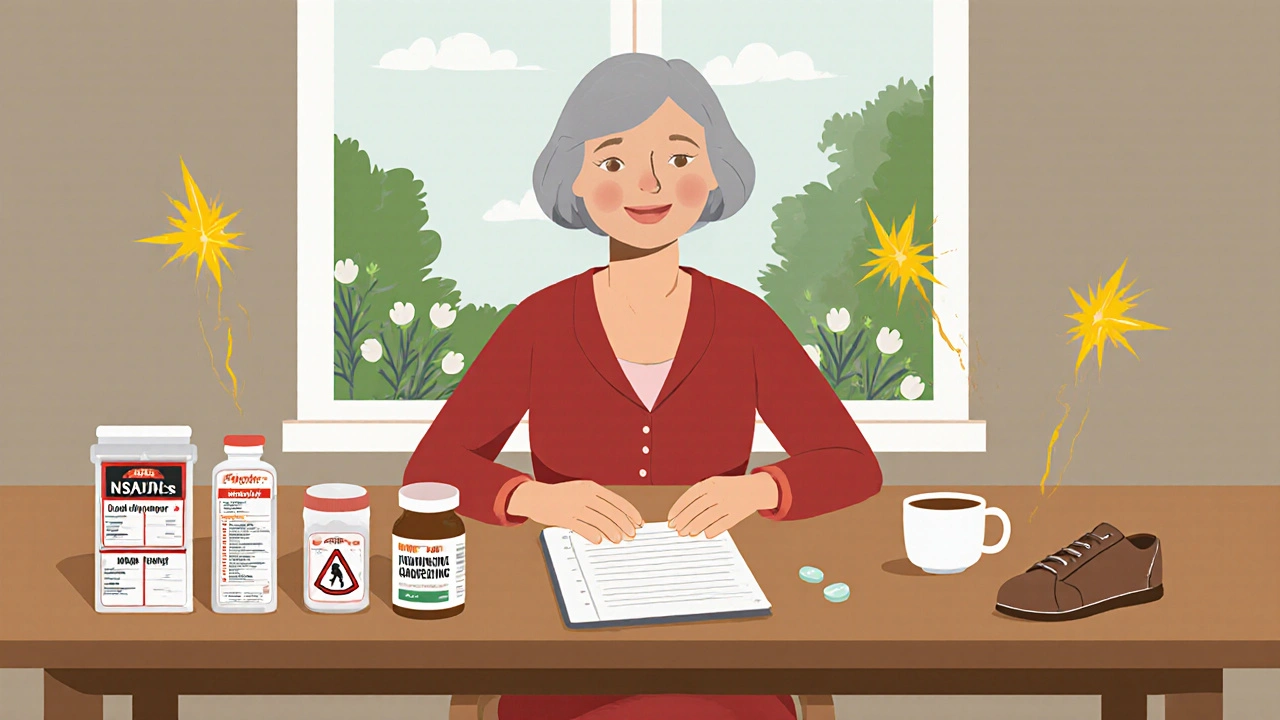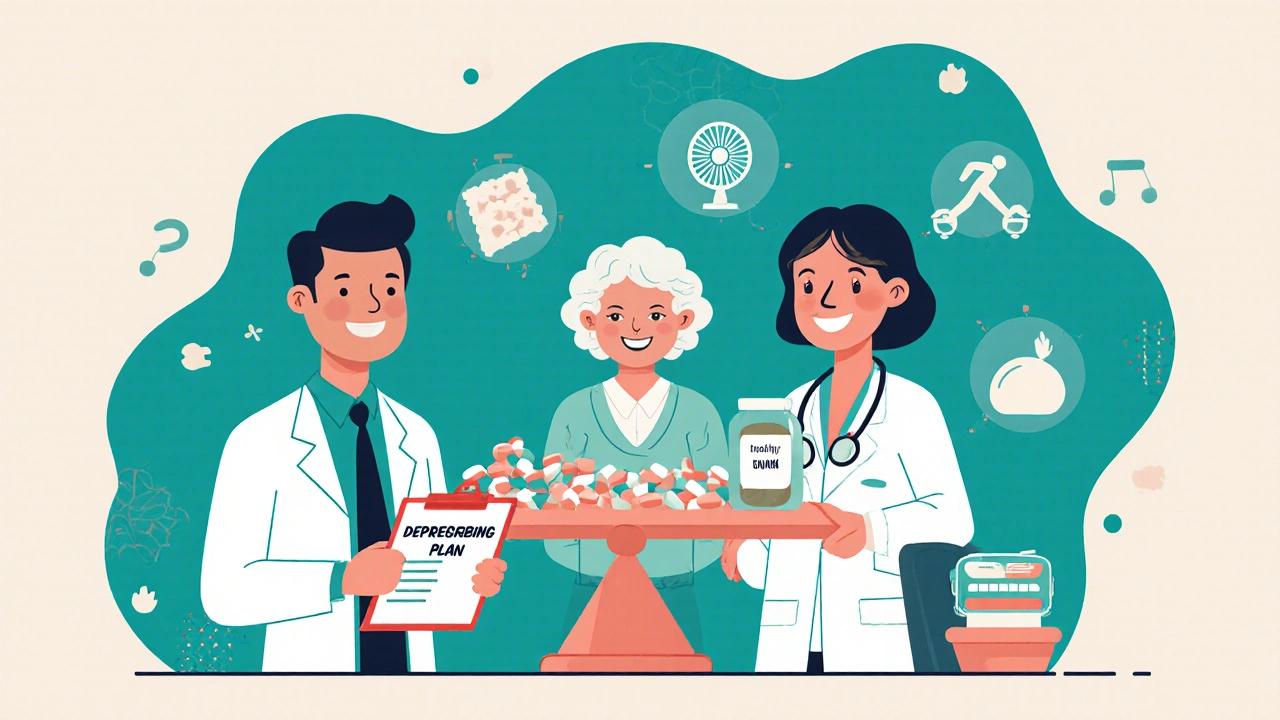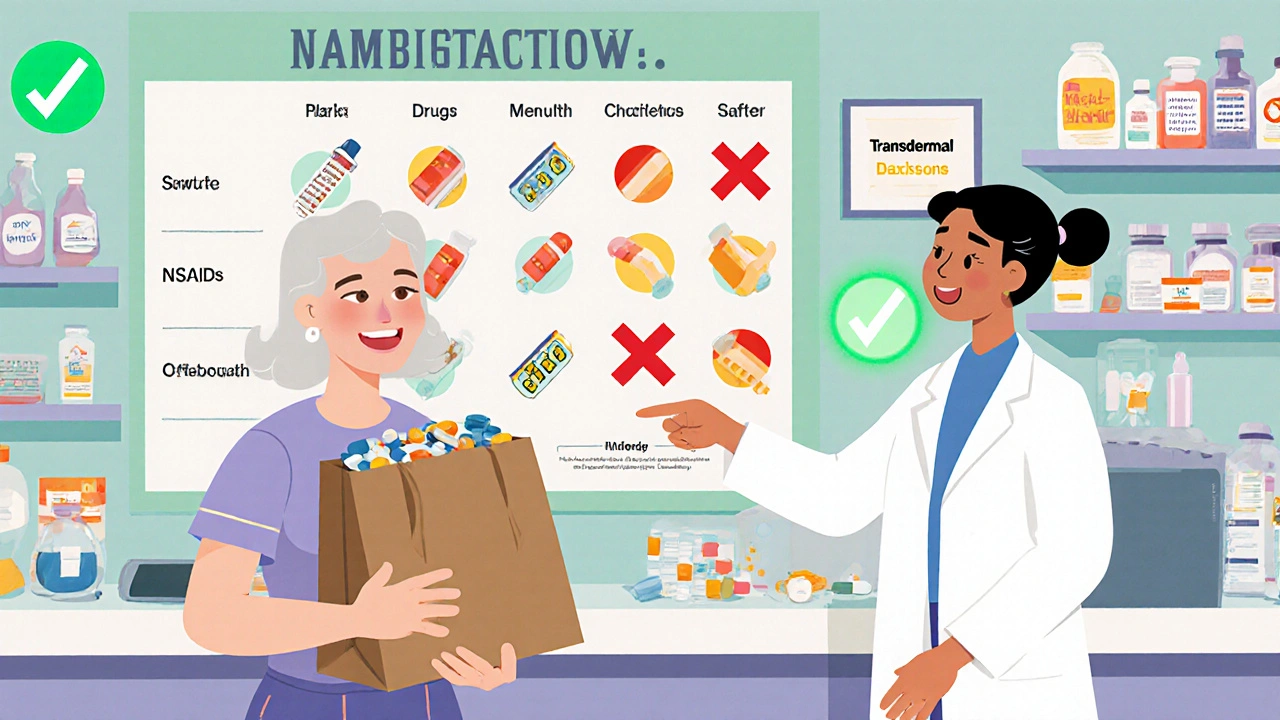When you’re past menopause, your body doesn’t just stop changing-it starts reacting differently to the medicines you take. What worked fine at 45 might become risky at 65. Hormones shift, kidneys slow down, liver function changes, and you’re likely taking more pills than ever. For many women, this is when medication errors, side effects, and hospital visits start climbing. The good news? You don’t have to guess your way through it. With the right knowledge, you can stay safe, feel better, and avoid unnecessary risks.
Why Your Body Responds Differently After Menopause
After menopause, estrogen levels drop sharply. That’s not just about hot flashes or sleep trouble. Estrogen affects how your liver processes drugs, how your kidneys filter them out, and even how your gut absorbs them. Without estrogen, many medications stick around longer in your system. That means even standard doses can become too strong. A 10 mg pill of a blood pressure drug that was perfect at 50 might cause dizziness or fainting at 65. It’s not that the drug changed-your body did.On top of that, most post-menopausal women take 4 to 5 prescription drugs daily. Some take more. A 2019 National Poll on Healthy Aging found that 44% of women over 65 are on five or more medications. That’s called polypharmacy. And it’s where things get dangerous. Each new drug adds a chance of interaction, side effect, or overdose. One pill might raise your blood pressure. Another might thin your blood. Together, they can push you into the hospital.
Hormone Therapy: The Biggest Safety Debate
Many women wonder if hormone therapy (HT) is still safe after menopause. The answer isn’t yes or no-it’s when and how.The Endocrine Society and U.S. Preventive Services Task Force agree: starting hormone therapy close to menopause (ages 50-59) for symptom relief is generally safe for healthy women. But starting it after 60-or more than 10 years after your last period-can increase your risk of stroke, blood clots, and breast cancer. That’s why timing matters more than the drug itself.
There’s also a big difference between oral and transdermal estrogen. Oral pills go through your liver first, which can raise clotting risks. Transdermal patches or gels skip that step. Studies show transdermal estrogen lowers the risk of venous thromboembolism by 30-50% compared to pills. If you have a history of clots, high triglycerides, or migraines with aura, transdermal is often the safer choice.
And don’t assume all hormone therapies are the same. The Women’s Health Initiative found that combined estrogen-progestin therapy increased breast cancer risk by 24% after 5.6 years. But estrogen-only therapy (for women who’ve had a hysterectomy) didn’t raise that risk-it actually lowered it slightly. That’s why your medical history determines your options.
Some women turn to tibolone, a synthetic hormone used in Europe. It helps with hot flashes and bone loss, but it raises stroke risk by 58%. It’s not FDA-approved, so if your doctor suggests it, ask why-and get a second opinion.
Non-Hormonal Options That Actually Work
You don’t need hormones to manage hot flashes, night sweats, or mood swings. Many women find relief with non-hormonal treatments, and some are even covered by insurance.SSRIs like paroxetine (Brisdelle) are FDA-approved for hot flashes. Studies show they reduce hot flash frequency by 50-60%. But there’s a catch: 30-40% of women report sexual side effects-lower libido, trouble with arousal. If sex life matters to you, this might not be the best fit.
Other options include gabapentin (used for nerve pain), which helps with night sweats, and clonidine (a blood pressure drug), which can reduce hot flashes by about 30%. Neither is perfect, but both are better than nothing if you’re avoiding hormones.
Even lifestyle changes help. Cooling your bedroom, wearing breathable layers, and avoiding spicy food or alcohol can cut hot flashes by half. Exercise doesn’t just improve mood-it stabilizes body temperature. Walking 30 minutes a day, five days a week, has been shown to reduce symptom severity in clinical trials.

Polypharmacy: The Silent Killer
Taking five medications sounds normal. But when you’re on eight or ten, the risks multiply. The World Health Organization says 40% of older adults get prescriptions from multiple doctors-each unaware of what the others prescribed. That’s how you end up with three blood thinners, two NSAIDs, and a sedative all at once.One real case: a 72-year-old woman was on diclofenac (an NSAID), simvastatin, enalapril, and atenolol. She kept taking the diclofenac even after her doctor told her to stop. Within a week, she bled internally. Her hemoglobin dropped from 12.5 to 8.1 g/dL. She ended up hospitalized. NSAIDs like diclofenac are on the Beers Criteria list-medications that should be avoided in older adults because they increase stomach bleeding and kidney damage.
The Beers Criteria (updated in 2019) lists 30 drugs to avoid in women over 65. That includes long-acting benzodiazepines like diazepam, which raise hip fracture risk by 50%. It includes anticholinergics like diphenhydramine (Benadryl), which can cause confusion and memory loss. And it includes certain diabetes drugs that cause dangerous lows.
Here’s what you can do: bring all your pills-prescription, over-the-counter, vitamins, herbs-to every doctor visit. This is called a “brown bag review.” Studies show it catches 70% of dangerous interactions before they cause harm.
Deprescribing: Less Is Sometimes More
You don’t have to keep every pill forever. Deprescribing-carefully stopping medicines that aren’t helping-is one of the most underused tools in women’s health.Research shows that structured deprescribing reduces medication burden by 1.4 drugs per person and cuts adverse drug events by 33%. But it’s not just about stopping. It’s about doing it safely. Benzodiazepines need to be tapered over 8-12 weeks. Antidepressants take 4-8 weeks. Stopping cold turkey can cause seizures, rebound anxiety, or heart rhythm problems.
Ask your doctor: “Is this medicine still necessary?” and “What happens if I stop it?” If you’ve been on a drug for years just because “it was prescribed,” it might be time to reassess. The START/STOPP criteria-a tool used by geriatricians-helps identify 116 inappropriate medications and 81 underused ones in older adults. Your pharmacist can help with this too.

Medication Errors Are More Common Than You Think
Even if you’re careful, mistakes happen. The National Poll on Healthy Aging found that 28% of women over 65 still make medication errors. The most common? Taking a pill twice (42%) or missing a dose (38%).Why? Pill organizers help-81% effectiveness, according to JAMA Internal Medicine-but only if you use them right. Don’t just dump everything in. Check expiration dates. Some pills lose potency fast. Don’t rely on memory. Write down why each pill is prescribed. If you can’t explain it, ask your doctor.
Also, don’t assume your doctor knows everything you’re taking. Supplements like St. John’s Wort, ginkgo, or high-dose vitamin E can interfere with blood thinners, antidepressants, and chemotherapy drugs. Tell your provider about every herb, vitamin, and tea you drink. They’re not judging-you’re keeping yourself safe.
What to Ask Your Doctor
Here are five questions to ask at your next visit:- Is this medication still necessary for me right now?
- Are there safer alternatives, especially non-hormonal ones?
- Could this interact with any of my other drugs or supplements?
- What side effects should I watch for, and when should I call you?
- Can we review all my medications together in one visit?
Don’t be afraid to ask for a medication review. Many clinics now offer them for Medicare beneficiaries with multiple chronic conditions. If yours doesn’t, ask your pharmacist. They’re trained in drug interactions and often have more time than your doctor.
Bottom Line: Take Control, Don’t Just Take Pills
Post-menopause isn’t the end of your health journey-it’s a new chapter. Your body’s changed. Your medicine needs to change with it. Don’t accept a pill just because it was prescribed years ago. Don’t fear hormone therapy if it’s right for you-but don’t ignore the risks either. Use transdermal options when possible. Avoid NSAIDs and sedatives unless absolutely needed. And always, always bring your pills to your appointments.The goal isn’t to take fewer drugs for the sake of it. It’s to take the right ones, at the right dose, for the right reason. That’s how you live well after 60-with energy, clarity, and confidence.
Is hormone therapy safe after menopause?
Hormone therapy can be safe if started close to menopause (ages 50-59) for symptom relief in healthy women. Starting after 60 or more than 10 years after your last period increases risks like stroke, blood clots, and breast cancer. Transdermal estrogen (patches or gels) is safer than oral pills, especially if you have a history of clots or migraines with aura. Estrogen-only therapy is an option if you’ve had a hysterectomy.
What medications should post-menopausal women avoid?
The Beers Criteria lists 30 medications to avoid in women over 65. These include long-acting benzodiazepines (like diazepam), which raise hip fracture risk by 50%; NSAIDs like diclofenac, which increase stomach bleeding; anticholinergics like diphenhydramine (Benadryl), which cause confusion; and certain diabetes drugs that cause dangerous low blood sugar. Always ask if a drug is on this list before starting it.
Can I stop taking a medication if I feel fine?
Never stop a medication without talking to your doctor-even if you feel fine. Some drugs, like blood pressure pills or antidepressants, need to be tapered slowly to avoid withdrawal symptoms or rebound effects. For example, stopping a benzodiazepine suddenly can cause seizures. Always ask your provider if a drug is still necessary and how to stop it safely.
How do I know if my medications are interacting?
Bring all your medications-including supplements and over-the-counter drugs-to your doctor or pharmacist for a “brown bag review.” This is the most effective way to catch dangerous interactions. Common risky combinations include NSAIDs with blood thinners, St. John’s Wort with antidepressants, and grapefruit juice with statins. Your pharmacist can run a free interaction check.
Are non-hormonal treatments effective for hot flashes?
Yes. SSRIs like paroxetine (Brisdelle) reduce hot flash frequency by 50-60%. Gabapentin helps with night sweats, and clonidine can cut flashes by about 30%. Lifestyle changes-cooling your room, wearing layers, avoiding alcohol and spicy food-can also reduce symptoms by half. These options are often safer than hormones, especially if you have a history of breast cancer or blood clots.
If you’re managing multiple medications, consider using a pill organizer with alarms and keeping a written list of all your drugs, doses, and reasons for taking them. Update it every time your prescription changes. You’re not just taking pills-you’re managing your health. And that’s worth doing right.


Justin Vaughan
October 31, 2025 AT 18:12Man, I wish I’d known this stuff 10 years ago. My mom was on like seven meds after 65-some she didn’t even know why she was taking. One was for high blood pressure she didn’t have anymore. She ended up in the ER from a bad interaction with her fish oil and blood thinner. This post? It’s the kind of thing that saves lives. Not just info-actionable, clear, no fluff.
Matthew Kwiecinski
November 2, 2025 AT 14:44The Beers Criteria is the single most underutilized clinical tool in geriatric care. If your doctor hasn’t referenced it in the last year, they’re not keeping up. Diclofenac in post-menopausal women? Absolute nightmare. And diphenhydramine? That’s not a sleep aid-it’s a cognitive destroyer. I’ve seen 80-year-olds become delirious from Benadryl. Stop it. Now.
Brittney Lopez
November 3, 2025 AT 09:15I’m a nurse and I’ve watched so many women get lost in pill regimens after menopause. The hardest part isn’t the meds-it’s the shame they feel asking, ‘Is this still necessary?’ They think admitting they don’t know is weakness. It’s not. It’s wisdom. Bring your brown bag. Ask the questions. You deserve to feel like yourself again, not like a pharmacy.
Keerthi Kumar
November 4, 2025 AT 14:45As an Indian woman who moved to the U.S. after 60, I was shocked how quickly doctors here pushed pills-no discussion, no alternatives. Back home, we used turmeric for inflammation, yoga for hot flashes, and talked to elders before starting anything. I asked my doctor about transdermal estrogen-he looked at me like I’d spoken Sanskrit. Please, women: don’t let cultural silence make you a statistic. Ask. Push. Research. Your body remembers your roots-even if your doctor forgets.
Dade Hughston
November 5, 2025 AT 05:05Okay so I just got off the phone with my doctor and he told me to stop my gabapentin cold turkey because he said it wasn't doing anything but I've been on it for 4 years and now I'm having like electric shocks in my arms and my heart is racing and I think I'm gonna die and I don't know what to do and I'm scared and I think my doctor is an idiot and I hate this system
Manuel Gonzalez
November 6, 2025 AT 06:12That last comment? That’s why we need better systems. Dade’s panic is real-and preventable. Deprescribing isn’t just stopping pills. It’s a process. A conversation. A plan. If your doctor says ‘just quit,’ they’re not helping-they’re dumping. Ask for a taper schedule. Ask for a follow-up in two weeks. If they roll their eyes? Find someone new. Your nervous system isn’t a switch. It’s a dial. Turn it down slowly.
Jens Petersen
November 7, 2025 AT 00:48Let’s be brutally honest: most of this ‘safe hormone therapy’ nonsense is Big Pharma’s way of keeping women docile and dependent. Transdermal estrogen? Still estrogen. Still increases cancer risk. Still a hormonal manipulation. And don’t get me started on SSRIs for hot flashes-antidepressants are not ‘non-hormonal’ solutions, they’re chemical bandaids on a systemic issue. The real solution? Accept aging. Stop fighting biology. Let your body be quiet. Stop medicating every natural shift.
Jim Peddle
November 8, 2025 AT 01:09Transdermal estrogen is a Trojan horse. The FDA approved it because the trials were funded by manufacturers. The 30-50% lower clot risk? Based on selective data. And who’s monitoring long-term outcomes? No one. Meanwhile, the Beers Criteria is being quietly ignored by every insurance company because it cuts their profits. This isn’t medicine-it’s a revenue stream disguised as care. You’re not being helped. You’re being monetized.
S Love
November 9, 2025 AT 05:22Hey Dade-I’m so sorry you’re going through this. You’re not alone. I’ve been there. The shock you’re feeling? That’s withdrawal. You need to call your doctor back right now and say: ‘I need a taper plan. I can’t stop this cold.’ If they say no, go to a pharmacist. They can help you build a safe schedule. You’re not weak for needing help. You’re brave for speaking up. And you’re not crazy. This stuff is hard. But you’ve got this. One step at a time.